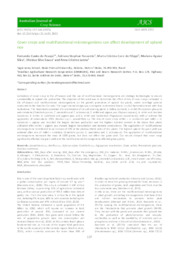Cover crops and multifunctional microorganisms can affect development of upland rice.
Cover crops and multifunctional microorganisms can affect development of upland rice.
Author(s): ARAUJO, F. C. de; NASCENTE, A. S.; FILIPPI, M. C. C. de; SILVA, M. A.; SOUSA, V. S.; LANNA, A. C.
Summary: Cultivation of cover crops in the off-season and the use of multifunctional microorganisms are strategic technologies to ensure sustainability in upland rice production. The objective of this work was to determine the effect of mix of cover crops cultivated in the off-season and multifunctional microorganisms on the growth promotion of upland rice plants, under no-tillage systems conducted in the Brazilian Cerrado. The experimental design was a complete randomized blocks in a 6x2 factorial scheme with four replications. The treatments consisted of a combination of six soil covering plants 1. Fallow (control); 2. millet (Pennisetum glaucum) and crotalaria (Crotalaria juncea, C. spectabilis and C. ochroleuca); 3. millet and pigeon pea (Cajanus cajanus); 4. millet and Urochoa ruziziensis; 5. millet, U. ruziziensis and pigeon pea; and 6. millet and buckwheat (Fagopyrum esculentum)), with or without the application of coinoculants 1301 (Bacillus sp.) + Azospirillum sp. The mix of cover crops millet + U. ruziziensis and millet + U. ruziziensis + pigeon pea recorded the largest biomass production and the highest nutrient content in the straw. Rice plants cultivated after millet + pigeon pea showed largest transpiration and stomata conductance. The application of multifunctional microorganisms contributed to an increase of 29% in the photosynthetic rates of rice plants. The highest upland rice grain yield was achieved after mix of millet + crotalaria (Crotalaria juncea, C. spectabilis and C. ochroleuca). The application of multifunctional microorganisms increased the mass of 1000 grains, but does not affect rice grain yield. Our results showed that cover crops significantly affected rice grain yield and the multifunctional microorganisms affected grain quality.
Publication year: 2021
Types of publication: Journal article
Unit: Embrapa Rice & Beans
Observation
Some of Embrapa's publications are published as ePub files. To read them, use or download one of the following free software options to your computer or mobile device. Android: Google Play Books; IOS: iBooks; Windows and Linux: Calibre.
Access other publications
Access the Agricultural Research Database (BDPA) to consult Embrapa's full library collection and records.
Visit Embrapa Bookstore to purchase books and other publications sold by Embrapa.

